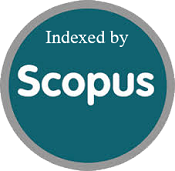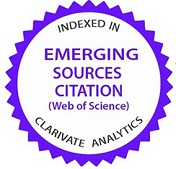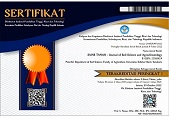Evaluating the efficacy of bacterial-assisted phytoremediation using maize (Zea mays L.) to uptake heavy metals from fly ash
Abstract
The agricultural sector faces dual challenges of declining soil fertility and unsustainable waste accumulation. This study examines the synergistic effects of fly ash (FA) and plant growth-promoting bacteria (PGPB) on the growth and physiological performance of maize (Zea mays L.) under controlled (potted) conditions. FA, a coal combustion by-product rich in essential minerals, was applied at varying doses (1–4 t ha-1) to assess its potential as a soil amendment with a bacterial strain (BSNK7) inoculated to enhance nutrient uptake and mitigate stress. Results showed a significant increase in fresh and dry biomass, leaf area, and chlorophyll content in treated plants. The combined application of 1 t ha-1 FA in conjunction with PGPB significantly increased fresh biomass by 1.57%, dry biomass by 0.94%, leaf area by 2.21%, and higher chlorophyll content compared to control (FA 0 t ha-1 and without bacteria). In contrast, FA 4 t ha-1, when applied without bacterial inoculation, resulted in reduced fresh biomass by 19.94% and dry biomass by 17.39%, respectively, compared to the control (FA 0 t ha-1 and without bacteria) which indicates the creation of toxicity at elevated doses. These findings suggest that the integrated use of low-dose FA and PGPB can sustainably enhance maize growth while minimizing environmental risks. The Application of appropriate doses of FA with PGPB can increase crop productivity and soil health simultaneously. Further field-based studies are recommended to validate scalability, optimize application rates, and assess the long-term impacts on soil health impacts.
Keywords
Full Text:
PDFReferences
A-Qureshi, A.-R., Al-Solaimani, S. G. M., Hindi, S. S. Z., Ibrahim, O. H., Mousa, M. A. A., & Shaheen, S. M. (2024). Impact of landfill fly ash on soil contamination with heavy metals in Rabigh Area, Saudi Arabia: Impact of landfill fly ash. Journal of King Abdulaziz University-Meteorology Environment and Arid Land Agriculture Sciences, 33(2). https://journals.kau.edu.sa/index.php/mealas/article/view/2347
Abhishek, S., Ghosh, A., & Pandey, B. (2024). A comprehensive review on phytoremediation of fly ash and red mud: exploring environmental impacts and biotechnological innovations. Environmental Science and Pollution Research. https://doi.org/10.1007/s11356-024-35217-2
Adriano, D. C., & Weber, J. T. (2001). Influence of Fly Ash on Soil Physical Properties and Turfgrass Establishment. Journal of Environmental Quality, 30(2), 596-601. https://doi.org/https://doi.org/10.2134/jeq2001.302596x
Al-Solaimani, S. G., Al-Qureshi, A., Hindi, S. S., Ibrahim, O. H., Mousa, M. A. A., Cho, Y.-L., . . . Shaheen, S. M. (2024). Speciation, phytoavailability, and accumulation of toxic elements and sulfur by humic acid-fertilized lemongrass and common sage in a sandy soil treated with heavy oil fly ash: A trial for management of power stations wastes. Science of The Total Environment, 945, 173998. https://doi.org/10.1016/j.scitotenv.2024.173998
Alghamdi, S. A., & El-Zohri, M. (2024). Phytoremediation Characterization of Heavy Metals by Some Native Plants at Anthropogenic Polluted Sites in Jeddah, Saudi Arabia. Resources, 13(7), 98. https://doi.org/10.3390/resources13070098
Alterary, S. S., & Marei, N. H. (2021). Fly ash properties, characterization, and applications: A review. Journal of King Saud University - Science, 33(6), 101536. https://doi.org/10.1016/j.jksus.2021.101536
Alves, A. R. A., Yin, Q., Oliveira, R. S., Silva, E. F., & Novo, L. A. B. (2022). Plant growth-promoting bacteria in phytoremediation of metal-polluted soils: Current knowledge and future directions. Science of The Total Environment, 838, 156435. https://doi.org/10.1016/j.scitotenv.2022.156435
Anbuganesan, V., Vishnupradeep, R., Bruno, L. B., Sharmila, K., Freitas, H., & Rajkumar, M. (2024). Combined Application of Biochar and Plant Growth-Promoting Rhizobacteria Improves Heavy Metal and Drought Stress Tolerance in Zea mays. Plants, 13(8), 1143. https://doi.org/10.3390/plants13081143
Asiminicesei, D.-M., Fertu, D. I., & Gavrilescu, M. (2024). Impact of Heavy Metal Pollution in the Environment on the Metabolic Profile of Medicinal Plants and Their Therapeutic Potential. Plants, 13(6), 913. https://doi.org/10.3390/plants13060913
Atta, M. I., Zehra, S. S., Ali, H., Ali, B., Abbas, S. N., Aimen, S., . . . Al-Ashkar, I. (2023). Assessing the effect of heavy metals on maize (Zea mays L.) growth and soil characteristics: plants-implications for phytoremediation. PeerJ, 11, e16067. https://doi.org/10.7717/peerj.16067
Azeem, M., Haider, M. Z., Javed, S., Saleem, M. H., & Alatawi, A. (2022). Drought Stress Amelioration in Maize (Zea mays L.) by Inoculation of Bacillus spp. Strains under Sterile Soil Conditions. Agriculture, 12(1), 50. https://doi.org/10.3390/agriculture12010050
Belov, A. A., Cheptsov, V. S., & Vorobyova, E. A. (2018). Soil bacterial communities of Sahara and Gibson deserts: Physiological and taxonomical characteristics. AIMS microbiology, 4(4), 685. https://doi.org/10.3934/microbiol.2018.4.685
Chandrakar, T., Jena, D., Dash, A., Jena, S., Panda, N., & Monica, M. (2015). Soil microbial activity as influenced by application of fly ash and soil amendments to maize crop in acidic alfisols. International Research Journal of Agricultural Science and Soil Science, 5(4), 120-128. https://www.interesjournals.org/articles/soil-microbial-activity-as-influenced-by-application-of-fly-ash-and-soil-amendments-to-maize-crop-in-acidic-alfisols.pdf
Chandwani, S., Ahire, V., Manoharadas, S., & Amaresan, N. (2025). Cobalt tolerant bacteria mobilize iron in garden pea (Pisum sativum L.) to mitigate cobalt stress in iron deficit soils. International Journal of Phytoremediation, 1-13. https://doi.org/10.1080/15226514.2025.2522304
Ciupa, T., Suligowski, R., & Kozłowski, R. (2019). Trace metals in surface soils under different land uses in Kielce city, south-central Poland. Environmental Earth Sciences, 79(1), 14. https://doi.org/10.1007/s12665-019-8762-6
Dinssa, B., & Elias, E. (2021). Evaluation of phosphate sorption capacity and external phosphorus requirement of some agricultural soils of the southwestern Ethiopian highlands. 2021, 18(2), 7. https://doi.org/10.20961/stjssa.v18i2.51325
Gupta, S., & Pandey, S. (2023). Plant Growth Promoting Rhizobacteria to Mitigate Biotic and Abiotic Stress in Plants. In N. K. Singh, A. Chattopadhyay, & E. Lichtfouse (Eds.), Sustainable Agriculture Reviews 60: Microbial Processes in Agriculture (pp. 47-68). Springer Nature Switzerland. https://doi.org/10.1007/978-3-031-24181-9_3
Haris, M., Ansari, M. S., & Khan, A. A. (2021). Supplementation of fly ash improves growth, yield, biochemical, and enzymatic antioxidant response of chickpea (Cicer arietinum L.). Horticulture, Environment, and Biotechnology, 62(5), 715-724. https://doi.org/10.1007/s13580-021-00351-0
Huo, Y., Kang, J. P., Ahn, J. C., Kim, Y. J., Piao, C. H., Yang, D. U., & Yang, D. C. (2021). Siderophore-producing rhizobacteria reduce heavy metal-induced oxidative stress in Panax ginseng Meyer. Journal of Ginseng Research, 45(2), 218-227. https://doi.org/10.1016/j.jgr.2019.12.008
Hussain, A., Faizan, S., Kumari, R., & Pandey, E. (2024). Morphological and biochemical responses of Vicia faba (faba beans) grown on fly ash amended soil in the presence of Rhizobium leguminosarum and arbuscular mycorrhizal fungus. Environmental Science and Pollution Research, 31(31), 44361-44373. https://doi.org/10.1007/s11356-024-34154-4
Jambhulkar, H. P., Shaikh, S. M. S., & Kumar, M. S. (2018). Fly ash toxicity, emerging issues and possible implications for its exploitation in agriculture; Indian scenario: A review. Chemosphere, 213, 333-344. https://doi.org/10.1016/j.chemosphere.2018.09.045
Kaur, H., Katyal, P., Chandel, S., Singh, D., Kumar, P., & Choudhary, M. (2024). Microbes mediated alleviation of chromium (Cr VI) stress for improved phytoextraction in fodder maize (Zea mays L.) cultivar. Heliyon, 10(23), e40361. https://doi.org/10.1016/j.heliyon.2024.e40361
Kinuthia, G. K., Ngure, V., Beti, D., Lugalia, R., Wangila, A., & Kamau, L. (2020). Levels of heavy metals in wastewater and soil samples from open drainage channels in Nairobi, Kenya: community health implication. Scientific Reports, 10(1), 8434. https://doi.org/10.1038/s41598-020-65359-5
Kumar, K. V., & Patra, D. D. (2013). Effect of metal tolerant plant growth promoting bacteria on growth and metal accumulation in Zea mays plants grown in fly ash amended soil. International Journal of Phytoremediation, 15(8), 743-755. https://doi.org/10.1080/15226514.2012.735287
Li, Y., Mo, L., Zhou, X., Yao, Y., Ma, J., Liu, K., & Yu, F. (2022). Characterization of plant growth-promoting traits of Enterobacter sp. and its ability to promote cadmium/lead accumulation in Centella asiatica L. Environmental Science and Pollution Research, 29(3), 4101-4115. https://doi.org/10.1007/s11356-021-15948-2
Masi, C., Gemechu, G., & Tafesse, M. (2021). Isolation, screening, characterization, and identification of alkaline protease-producing bacteria from leather industry effluent. Annals of Microbiology, 71(1), 24. https://doi.org/10.1186/s13213-021-01631-x
Miller, R. O., & Kissel, D. E. (2010). Comparison of Soil pH Methods on Soils of North America. Soil Science Society of America Journal, 74(1), 310-316. https://doi.org/10.2136/sssaj2008.0047
Nayak, A. K., Raja, R., Rao, K. S., Shukla, A. K., Mohanty, S., Shahid, M., . . . Swain, C. K. (2015). Effect of fly ash application on soil microbial response and heavy metal accumulation in soil and rice plant. Ecotoxicology and Environmental Safety, 114, 257-262. https://doi.org/10.1016/j.ecoenv.2014.03.033
Panda, S., Mishra, L., Muduli, S., Nayak, B., & Dhal, N. (2015). The effect of fly ash on vegetative growth and photosynthetic pigment concentrations of rice and maize. Biologija, 61(2). https://doi.org/10.6001/biologija.v61i2.3143
Parry, C., Blonquist Jr., J. M., & Bugbee, B. (2014). In situ measurement of leaf chlorophyll concentration: analysis of the optical/absolute relationship. Plant, Cell & Environment, 37(11), 2508-2520. https://doi.org/10.1111/pce.12324
Pattnaik, S., Mohapatra, B., & Gupta, A. (2021). Plant Growth-Promoting Microbe Mediated Uptake of Essential Nutrients (Fe, P, K) for Crop Stress Management: Microbe–Soil–Plant Continuum [Review]. Frontiers in Agronomy, Volume 3 - 2021. https://doi.org/10.3389/fagro.2021.689972
Permatasari, R., Sodri, A., & gustina, H. A. (2023). Utilization of Fly Ash Waste in the Cement Industry and its Environmental Impact: A Review. Jurnal Penelitian Pendidikan IPA, 9(9), 569-579. https://doi.org/10.29303/jppipa.v9i9.4504
Ram, L. C., & Masto, R. E. (2010). An appraisal of the potential use of fly ash for reclaiming coal mine spoil. Journal of Environmental Management, 91(3), 603-617. https://doi.org/10.1016/j.jenvman.2009.10.004
Rinawati, M., Sari, L. A., & Pursetyo, K. T. (2020). Chlorophyll and carotenoids analysis spectrophotometer using method on microalgae. IOP Conference Series: Earth and Environmental Science, 441(1), 012056. https://doi.org/10.1088/1755-1315/441/1/012056
Rizwan, M., Ali, S., Qayyum, M. F., Ok, Y. S., Zia-ur-Rehman, M., Abbas, Z., & Hannan, F. (2017). Use of Maize (Zea mays L.) for phytomanagement of Cd-contaminated soils: a critical review. Environmental Geochemistry and Health, 39(2), 259-277. https://doi.org/10.1007/s10653-016-9826-0
Singh, V. K., Singh, A. K., Singh, P. P., & Kumar, A. (2018). Interaction of plant growth promoting bacteria with tomato under abiotic stress: A review. Agriculture, Ecosystems & Environment, 267, 129-140. https://doi.org/10.1016/j.agee.2018.08.020
Susilowati, L. E., Sukartono, S., Akbar, M. F., Kusumo, B. H., Suriadi, A., Leksono, A. S., & Fahrudin, F. (2024). Assessing the synergistic effects of inorganic, organic, and biofertilizers on rhizosphere properties and yield of maize. Sains Tanah Journal of Soil Science and Agroclimatology, 21(1), 13. https://doi.org/10.20961/stjssa.v21i1.85373
Tagami, K., & Uchida, S. (2025). Fundamental study on measurement of soil pH and electrical conductivity in batch tests for the determination of soil-soil solution distribution coefficient. Nuclear Engineering and Technology, 57(3), 103269. https://doi.org/10.1016/j.net.2024.10.031
Tipu, M. I., Ashraf, M. Y., Sarwar, N., Akhtar, M., Shaheen, M. R., Ali, S., & Damalas, C. A. (2021). Growth and Physiology of Maize (Zea mays L.) in a Nickel-Contaminated Soil and Phytoremediation Efficiency Using EDTA. Journal of Plant Growth Regulation, 40(2), 774-786. https://doi.org/10.1007/s00344-020-10132-1
Usman, M., Anastopoulos, I., Hamid, Y., & Wakeel, A. (2023). Recent trends in the use of fly ash for the adsorption of pollutants in contaminated wastewater and soils: Effects on soil quality and plant growth. Environmental Science and Pollution Research, 30(60), 124427-124446. https://doi.org/10.1007/s11356-022-19192-0
Usmani, Z., Kumar, V., Gupta, P., Gupta, G., Rani, R., & Chandra, A. (2019). Enhanced soil fertility, plant growth promotion and microbial enzymatic activities of vermicomposted fly ash. Scientific Reports, 9(1), 10455. https://doi.org/10.1038/s41598-019-46821-5
Varshney, A., Dahiya, P., Sharma, A., Pandey, R., & Mohan, S. (2022). Fly ash application in soil for sustainable agriculture: an Indian overview. Energy, Ecology and Environment, 7(4), 340-357. https://doi.org/10.1007/s40974-022-00241-w
Wang, N., Sun, X., Zhao, Q., Yang, Y., & Wang, P. (2020). Leachability and adverse effects of coal fly ash: A review. Journal of Hazardous Materials, 396, 122725. https://doi.org/10.1016/j.jhazmat.2020.122725
Yaashikaa, P. R., Kumar, P. S., Jeevanantham, S., & Saravanan, R. (2022). A review on bioremediation approach for heavy metal detoxification and accumulation in plants. Environmental Pollution, 301, 119035. https://doi.org/10.1016/j.envpol.2022.119035
Zhang, Y., Zhao, S., Liu, S., Peng, J., Zhang, H., Zhao, Q., . . . Chen, C. (2022). Enhancing the Phytoremediation of Heavy Metals by Combining Hyperaccumulator and Heavy Metal-Resistant Plant Growth-Promoting Bacteria. Frontiers in Plant Science, Volume 13 - 2022. https://doi.org/10.3389/fpls.2022.912350
Refbacks
- There are currently no refbacks.











.png)





